NOAA Bell M. Shimada
National Oceanic and Atmospheric Administration
Overview
The NOAA Ship Bell M. Shimada will be the U.S. research vessel contributing to the IYS 2022 Pan-Pacific Winter High Seas Expedition. The ship was commissioned in 2010 and is one of five advanced fisheries research vessels operated by NOAA. She is named after a respected tropical Pacific tuna researcher, Dr. Bell M. Shimada (1922-1995). The ship is capable of conducting multidisciplinary oceanographic operations in support of biological, chemical, and physical process studies. The Bell M. Shimada uses Newport, Oregon as her home port but operates along the entire United States West Coast. She is used to monitor fisheries and protected species including albacore, sharks, salmon, groundfish, sardines, and hake, make weather observations, conduct habitat assessments, and survey marine mammal and marine bird populations. Her advanced capabilities for trawling, physical and biological oceanography, extensive lab space, and large scientific crew, make her a perfect fit for the IYS 2022 Expedition.

UPDATES FROM THE SHIP
Click on photo gallery to enlarge images!
This is our final day at sea, marking the completion of the USA’s contribution of sea time to the 2022 IYS High Seas Expedition. We arrived off the coast of Newport yesterday evening, and have been waiting a few miles offshore for the afternoon high slack tide. The scientific party and ship’s crew have been busy preparing for port, cleaning, packing and stowing the myriad materials that will need to come off the ship tomorrow.
The end of a research cruise is often an exciting if slightly bittersweet time. On the one hand, the imminent return to the many comforts of shore and home is a naturally joyful moment, as those comforts taken for granted by landlubbers are keenly appreciated by those who’ve done without them for some while. On the other hand, there will be many farewells among friends new and old, as everyone makes their way home over the coming day or two.
The work of the IYS is far from over, however, and many of us will gather again in the coming months and years, together with our colleagues from the other ships and nations participating in IYS, to put together the many puzzle pieces we collected. Some important questions will no doubt be answered, and many more will likely be raised, as we delve into the trove of data we have acquired.
We’ve completed sampling, with two final stations on the southern side of the Canadian sector (46 and 45N, 135W). At this point in the survey, the team is operating very smoothly and things start to blend together a bit– a couple CTD casts, a plankton net haul or two, and the surface trawl with some number of salmon, squid, and lanternfish. But last night was quite different. When the cod end of the net came aboard, one of the skilled fishers yelled “Shark!” We had finally caught a salmon shark (Lamna ditropis), which meant a whole different set of activities kicked into gear.The 6 1/2′ long shark was released from the net and seemed feisty, but calmed down when a wet black towel was placed over her eyes. Working quickly, scientists attached an electronic tag to her dorsal fin, which reports the shark’s location to satellites whenever the shark’s fin breaks the surface, and a pop-off archival satellite tag to the shark’s side, which will record the shark’s depth and the temperature of surrounding water. After a programmed period of time (in this case, one year), the tag will release from the shark, float to the surface, and transmit the collected data back to shore via satellite.
Salmon sharks are so named because they eat salmon, as well as other fish and squid. They are in the same family as the white shark and mako shark, and like those sharks, the salmon shark maintains an elevated internal body temperature, making them effective predators in cold waters. The data from tagged salmon sharks will help us better understand their overlap with the different species of Pacific salmon and the degree to which salmon sharks are a significant predator of salmon. After a lengthy process, we christened her “Sharkira.”
Last night we completed sampling along the 147 line with a haul at 47N, where we caught a mix of Chinook, chum, pink and coho salmon, along with several large Boreal clubhook squid, many smaller gonatid squid, and some blue lanternfish. The coho seemed very well fed, absolutely stuffed with squid and lanternfish.
Today we are sailing east, a bit out of the way to Newport OR, to attempt to recover a broken-down wave glider. Wave gliders are autonomous vehicles that travel on the ocean surface, propelled by energy they capture from waves. They can carry a variety of oceanographic instruments and send data to shore by satellite.
After our rendezvous with the wave glider, we will sail to Newport, possibly stopping for some bonus stations if time and weather permit. We are currently between two storm systems, and would like to stay there as these systems move east.
Throughout this survey, we have been collecting data on the properties of the upper ocean using a conductivity-temperature-depth recorder (CTD) that is attached to a frame holding a dozen water sampling bottles. From the traces recorded by the CTD, we can see how deep the well-mixed surface layer is. Winter mixing is an important process in the North Pacific– deep mixing suppresses production in the winter but brings nutrients to the mixed layer, fueling production in the spring when the surface layer stratifies as it heats from the surface. Water samples are taken for measuring the nutrient, chlorophyll (a pigment carried by primary producers, the plant-like plankton at the base of the food web), and oxygen content of the waters down to a depth of 500 or 1000 meters. Weather: cloudy, wave 2′, swell 4′, winds 20kts from ENE.
Last night we transited northeast to 49N, 147W after finishing the southern end of the 151.5W line with a bang. We made good time with a following swell pushing us along. As expected, waters here are cooler, with sea surface temperature around 6C. Our morning trawl brought up 4 sockeye salmon, some jellies and one heteropod, a pelagic snail-like, transparent mollusc roughly the size and shape of a gyoza dumpling.
While our trawl catches will give us a good sense of the broad-scale distribution of salmon, we are gathering other samples that will provide a much higher-resolution view. The ship continuously draws in seawater and sends that to the onboard laboratory, where it is routinely analyzed for its chlorophyll content (a measure of the abundance of photosynthetic plankton), conductivity and temperature. On this cruise, this water is also being sampled for DNA. Animals shed cells as they go about their lives and deaths, and these can be concentrated on filters. Using the incredibly powerful tools developed originally for human genome sequencing, one can determine what kinds of organisms are in the area by applying these tools to the filters, looking for the species-specific genetic “fingerprints” left behind in the ocean. The samples we are collecting will be probed not only for Pacific salmon species, but also salmon predators, such as salmon sharks, Pacific daggertooth, seabirds, and various marine mammals. Analysis of environmental DNA is so powerful that extreme care must be taken to avoid contamination; one can sometimes tell what was served in the galley at meal time. At the end of the cruise, we will have samples representing each 10-mile segment of our cruise track that can aligned with the oceanographic data that collected concurrently, giving us a picture of the overlap between salmon and their predators, and how those distributions relate to oceanographic features across the North Pacific. Weather was partly to mostly cloudy; winds 20-25 kts; seas 3-5′ with 8′ swell.
We continue our survey heading south along the 151.5W line. Our core activity is catching salmon with a surface trawl net, and collecting typical measurements from the catch: length, weight, and samples from a variety of tissues that will tell us more about the life of salmon on the high seas. These include scales, which add rings as they grow and can be used to determine how old the salmon was; otoliths, which similarly add rings and can be used for very accurate age estimation; fin clips for genetic stock identification; stomach contents to identify what the salmon have been eating, if anything; gonads, to determine sex, develomental state, and how much energy salmon are putting into maturation; blood, for measuring growth hormone levels; and muscle and liver tissue, to determine how much energy reserves salmon have for growth and maturation. Analyzing the materials we have collected will take months of work back in laboratories on land.
We are also collecting samples from the jellies and other animals caught in the trawl, plankton nets, and filtered from seawater. The goal of this work is to understand how energy and materials flow through the food web, of which the different salmon species are just parts.
Several tools are useful for . One is analysis of the stable isotopes of carbon and nitrogen. The ratios of rare heavy varieties of atoms to the common lighter variety can establish the position of different animals in the food web– who is eating whom. Fatty acids also provide insight into this question. Certain fatty acids are produced only by certain organisms, and other organisms get them from their diet. Thus, the kinds of fatty acids found in an animal tell you something about what it has been eating, tracing these tropic links back to the bottom of the food web. Through the analysis of all these data collected across the breadth of the North Pacific, we hope to obtain a much clearer understanding of the conditions that cause salmon to flourish or struggle, crucial knowledge to understand the future of salmon in a changing ocean.
We had by far our largest catch of the survey this morning at the southernmost station on the 151.5 line– 5 chinook, 2 pink, 29 chum and 9 sockeye. Sea surface temperature was a balmy 7.7C.
We arrived on station at 50N, 151.5W shortly after midnight, and proceeded with our usual schedule of sampling. Jellyfish were very abundant near the surface at this station, so we did just a 30 minute tow to avoid ripping the net, and nonetheless caught a good pile of jellies, along with 4 sockeye and 1 chum salmon, our first of the trip. The chum had a deformed head– the upper jaw was short, giving it a massive underbite. It also bore fresh wounds, evidence of a recent attack by a North Pacific daggertooth (Anotopterus nikparini).
After grabbing a bit of sleep, we arrived at 49N, 151.5W for our second of three stations for the day. Sea surface temperatures are now above 6C and there are more signs of life at the surface, with several Laysan albatrosses and a few puffins on the water. Our two-hour trawl caught 12 salmon– 10 chum, a pink and a sockeye. The chum salmon looked thin, and had empty stomachs and enlarged gall bladders, suggesting they were struggling to find enough food. We are collecting samples to measure growth hormones when we return to land, which will tell us whether they are indeed growing slowly. Our plankton tows caught very little– a few large copepods and arrow worms, slim pickings for salmon.
We will head further south and sample at the 48S station this evening. Weather was Cloudy, calm winds, 12′ swell. Very early this morning we had some snow showers.
Today we are moving to the western line at 151.5W to fill in some sampling gaps and stay away from unworkable winds and seas. We should arrive there at 50N tomorrow morning.
Last night we caught 7 sockeye at 52N, 147W, following a catch of three sockeye in the morning at 53N, 147W. Many of these fish again had enlarged, green gall bladders indicating poor feeding conditions, but the fish caught at night generally had stomachs stuffed with krill. It was too windy at these stations to effectively tow our plankton nets. Other things that have turned up in the trawl net include a juvenile prowfish, a lanternfish, and a few more lumpfish, along with the usual assortment of jellies and squid.
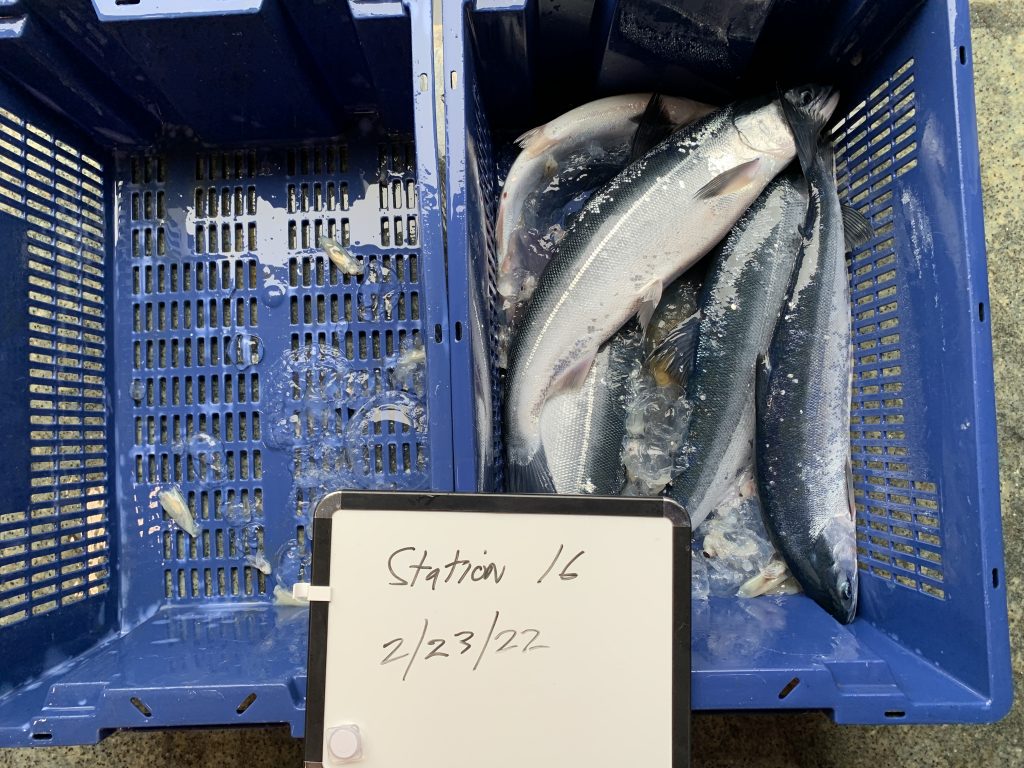
We continue sampling along the 147W line, heading south. Catches have been picking up along the way as sea surface temperatures rise slightly, with 5 nice sockeye salmon caught yesterday morning. Seas were too rough last night to fish, but today they calmed enough to get the net out for a 2-hour tow, resulting in 3 more sockeye salmon and a variety of jellies, including a lion’s mane. Heavier weather is expected tonight through tomorrow, probably curtailing our sampling for a day or two.
Many of the sockeye salmon have exhibited enlarged gall bladders, indicating they have been experiencing poor feeding conditions.
We continue working south along 147W, Sea surface temperatures remain cold, only just rising above 4C on our way to 55N. We caught a single sockeye salmon at this morning’s station at 56N, along with a smattering of invertebrates. Last evening, at 57N, the only fish caught were two small lumpsuckers, each about the size and shape of a large grape. Our nighttime Tucker trawl (a large plankton net) yielded some euphausiids, a favorite prey of sockeye salmon, but the myctophids visible on the sonar must be too good of swimmers to be caught by this net, and still too deep for our surface trawl in the late evening.

We arrived at Station 12 (58N, 147W) in the morning and conducted our usual suite of activities: shallow and deep CTDs, vertical plankton tow, and a surface trawl. In addition, we deployed an Argo float. These floats change their buoyancy to make periodic dives as they drift around the ocean, recording temperature, salinity and pressure along the way. While at the surface, they transmit their data by satellite to data centers on land, adding to a large and growing collection of ocean observations supporting myriad uses, including weather forecasting and measuring the increasing heat content of the oceans.
The catch in the trawl at Station 12 was light– a single small sockeye, a couple stickleback and a snailfish, along with a few dozen Gonatus squid, fried egg jellies, and other jellies.
The plankton tow captured some copepods and gelatinous zooplankton, but the overall biomass was low, reflecting the low productivity of these northern waters in the depth of winter. Weather was very cloudy/foggy with 3-4′ seas. Visibility ~2 km.
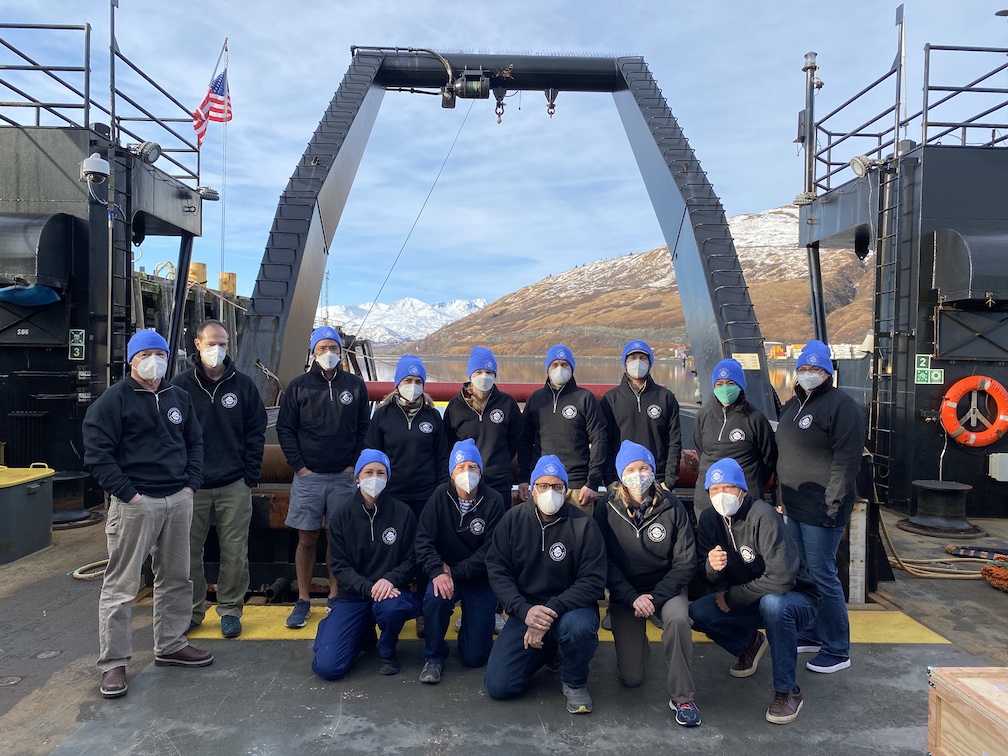
Today the Shimada departed Kodiak, Alaska after taking on fuel and exchanging crew. Before departing, we conducted fire and abandon-ship drills. We are heading east to the 147W line to begin sampling the northernmost station tomorrow morning, after an 18 hour transit. This northernmost stations is quite cold (~3C) so we are not expecting many salmon there, but catches will hopefully increase as we work south. But the ocean is full of surprises. Reasonably moderate weather and seas expected for the next few days.
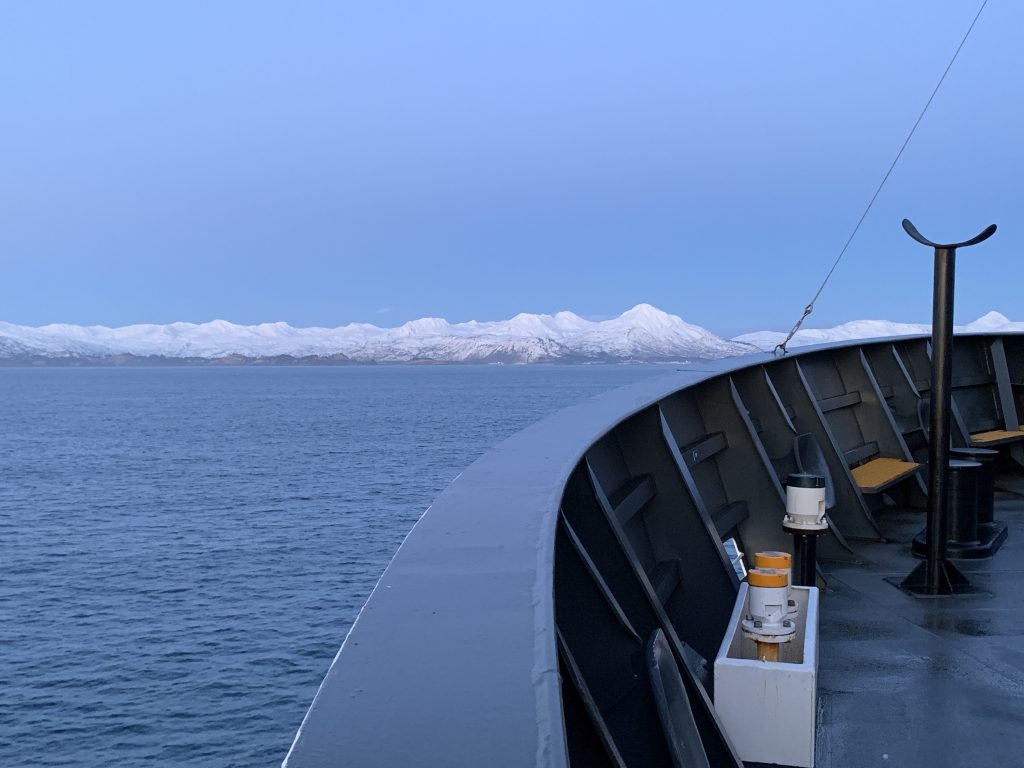
So we’re not done with Leg 1 yet! If everything goes as expected (hoped?), we’ll arrive in Kodiak Sunday morning, anchor out in the bay so they can make necessary repairs with the engines off in calm water, and then we’ll be heading back out tomorrow evening. Our plan is to do several of the stations on the 151.5’W line before we return to Kodiak on Feb 16 as originally planned. Everyone is in a much better mood knowing we’ll get in a little more sampling before the science team change!
The long grey cylinder thingie that we are deploying is an Argos float. We’ve got 2 more to deploy on our next 2 stations (at 58’N, 147W, and 57’N, 147W). We had to be really careful not to scratch it because subsequent corrosion at the scratch would change the balance of the whole thing making it not work, and we had to be extra careful not to hit the top into the ship because the instruments are exposed and very fragile. Glad we got it in without incident!
Heading north again. Went down to 55’N yesterday but the wind and waves were larger than forecast so we tried to do a vertical zooplankton and fish but had to abort both. Spent wee hours this morning in the vicinity of 56’N successfully doing five 1000 m CTD casts to measure the strength of the Alaska stream, then just finished fishing for 1.5 hours only to catch 3 fried egg jellies and some pieces of water jelly but no salmon. Bummer! Water is cold (3.5’C) so perhaps a bit chilly even for sockeye? Heading up to 57’N (slope station) to try yet again. Weather is supposed to come in again late tonight/early tomorrow so we’re hopeful we’ll make one, maybe two stations before heading into Kodiak tomorrow.
Heading to the next station. Some video clips that will make you turn green (it never looks as bad as it is, but these are pretty good).
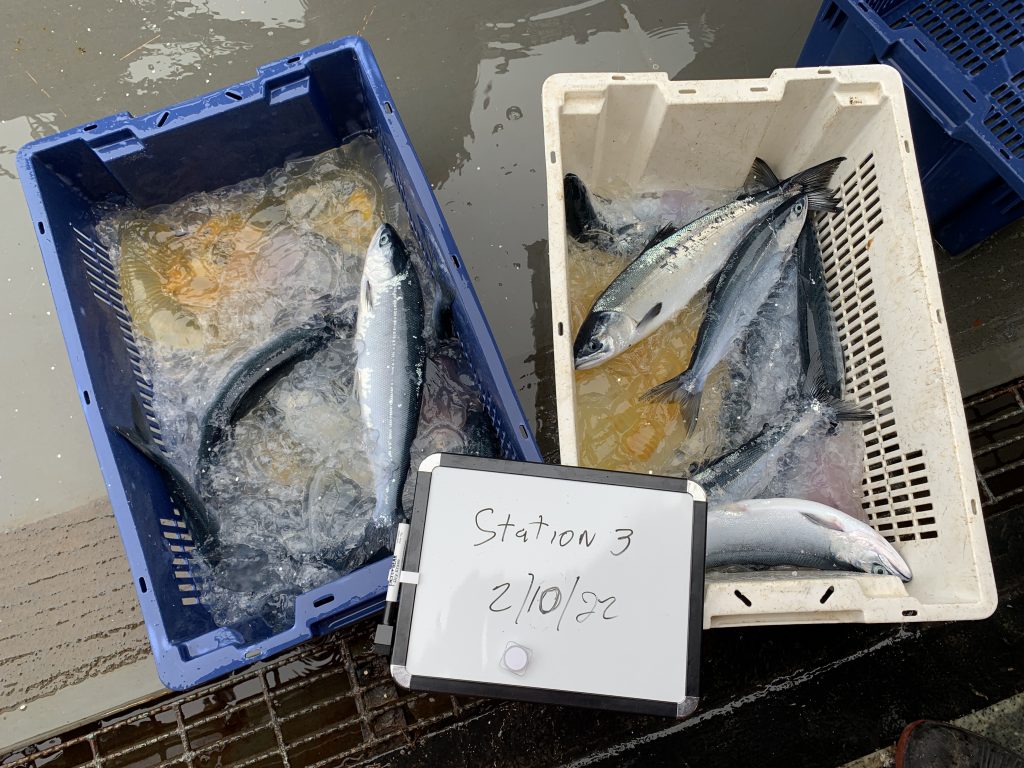
The moment we’ve all been waiting for. We caught salmon! Did our first “official” station today at 50’N, 146.5’W and caught 12 sockeye and 3 chum! Lots of excitement as everyone wanted to see the catch, but also a bit of a scramble trying to determine the proper workflow, where to take the various samples, and in what order, etc. Yeah salmon!!!!! Yellow stuff is egg yolk (or fried egg) jellyfish. Pretty exciting!
Still transiting. Everyone really looking forward to actually starting to sample! Expect to be on station around 8am on Feb 10.

Transiting to our first “official” station, which will be at 50°N, 146.5°W which we expect to reach on Feb 10. Some people are working, others watching movies or reading, some do bird and marine mammal observations from the bridge, others have long conversations about saving the world. Seas 10-15 feet, almost sunny in the afternoon.
We steamed southwest most of the night, hoping to get around the southern end of a large storm that is parked in the vicinity of our target sampling stations. We decided to make a short detour to collect samples from the nearby Cobb Sea Mount (46°44′N, 130°47′W). The Cobb seamount is an undersea volcano that starts at roughly 2,600 m below the surface and rises to within just 34 m of the surface. We know seamounts are productive regions that attract sea life, so we thought we might get some exciting catches in both the plankton and trawl nets. Unfortunately, we had a slight problem with the trawl (the end of the trawl came loose). So we didn’t catch anything in the trawl. And the first glance at the plankton didn’t provide any big surprises either. You win some, you lose some. We’ll keep heading west and sample another station tomorrow.
We started operations at 8:00 am with one last gear trial. Once the net was “flying” satisfactorily, we retrieved the net, closed the codend, and fished for an hour. We followed that up with CTD casts and a zooplankton tow.
The catch was relatively low and included a dozen jellyfish and about 45 planktonic tunicates known as salps. One interesting discovery in the net was a small daggertooth (Anotopterus nikparini), about 14 inches long. Daggertooths make their living using their extremely sharp teeth to slash pieces of flesh from fish (including salmon) and then consuming the pieces. We caught salmon in previous expeditions in 2019 and 2020 with characteristic vertical wounds likely resulting from daggertooth attacks. Speaking of salmon, we haven’t found any salmon in the net yet. But we’re interested to see if the eDNA water samples we took “caught” any salmon.
These early gear deployments may not have resulted in large catches, but they were precisely what we needed to get organized, put our workflow into action (and quickly find all the things we overlooked), and make sure we located all the bags, vials, labels, and logbooks we needed for each type of sample we collected.
There’s a lot of excitement aboard. And it was a bit hectic when these initial trawl, CTD, and plankton tows came on board. Everyone wanted to see what we caught in the nets or help collect water from the Niskin bottles. Also, we’re still figuring out which samples to collect, where they go (we have several freezers plus chemical preservatives), and where to record all the samples.


After steaming all night, we arrived back in Port Angeles mid-morning. We offloaded the damaged net, loaded two good nets, and headed back offshore. The science team spent most of the day organizing the labs, labeling the many tubes and vials we’ll use, determining workflow once the catch and water (from the CTD rosette) come on board, and otherwise kept busy.
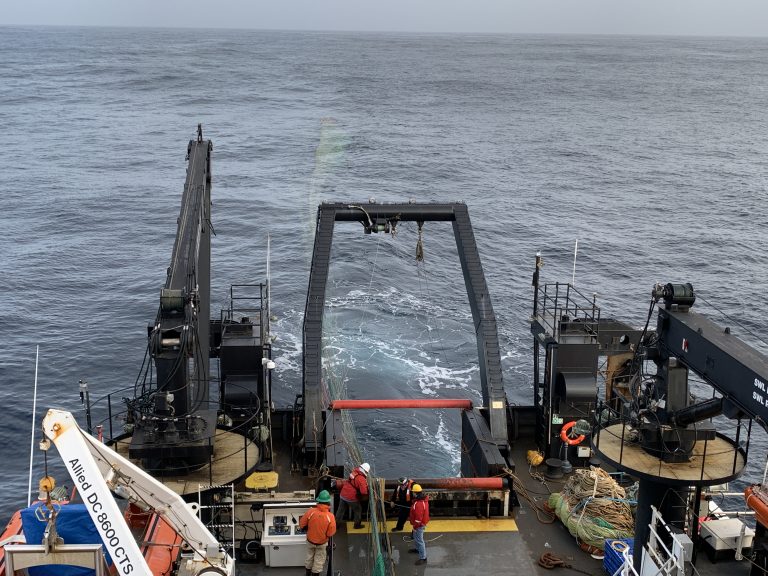
The next morning, after steaming southwest most of the night, reached the western edge of the US Exclusive Economic Zone, almost 200 miles from the mainland. There we slowed to conduct gear trials on the trawl. This entailed streaming the net to ensure we’d connected all the cables and harnesses properly and there weren’t any twists of the net. Then, we deployed the net and made adjustments, so it was “flying” properly. And good thing we did. As we reeled the net back to the ship, we noticed the net was damaged. This necessitated a rapid change of plans. So we headed back toward Port Angeles, where spare nets should be waiting for us in the morning.
After pulling anchor, we steamed into the protected waters of the Strait of Juan de Fuca. There, we performed gear trials on the two plankton nets (bongo and Tucker trawl), the CTD rosette, and the profiling radiometer system. These trials ensure all the gear and sensors are working correctly, hardware is compatible with winch cable connections, and we understand how to deploy less familiar equipment (Tucker trawl, radiometer). We took advantage of the flat water and light winds within the Strait of Juan de Fuca for these trials, making them much easier to do than in the rough seas we expect to encounter farther west.
Science team members also spent most of the day setting up the labs and securing gear in preparation for rougher waters.
In the afternoon, we briefly returned to Port Angeles. After completing all COVID protocols, we brought aboard the four scientists who were originally going to board the ship in Ketchikan, Alaska. Now, we have our full science team of 14 with Ed Farley from the Alaska Fisheries Science Center officially taking the reins as Chief Scientist for Leg 1.
By the end of the day, we were ready to sail west out of the Strait of Juan de Fuca and towards our first sampling grid.

The CTD rosette is the refrigerator-sized cylindrical white frame with all the dark grey Niskin bottles that scientists on board will be using. In the middle of the frame is the CTD instrument, which measures Conductivity (i.e., salinity), Temperature with Depth. It also has a bunch of other sensors for things like oxygen, water clarity, chlorophyll (it actually measures light absorption, and Chl is estimated by the amount absorbed), etc. The Niskin bottles can be tripped at any depth and so they are able to collect water at specific depths for things like nutrients, oxygen (a different way to measure it), and Christoph Deeg and Kristi Miller-Saunders’ famous eDNA (environmental DNA). Scientists will lower it down to 500m at most stations, and down to 1000 m at the others.

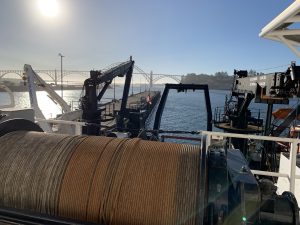
The NOAA Bell M. Shimada has arrived in Port Angeles, WA from Newport, OR where she will dock until all the scientists and crew have been cleared for negative COVID tests.
The Scientific Team
Meet the fascinating team of scientists on board the United States research vessel the NOAA Ship Bell M. Shimada
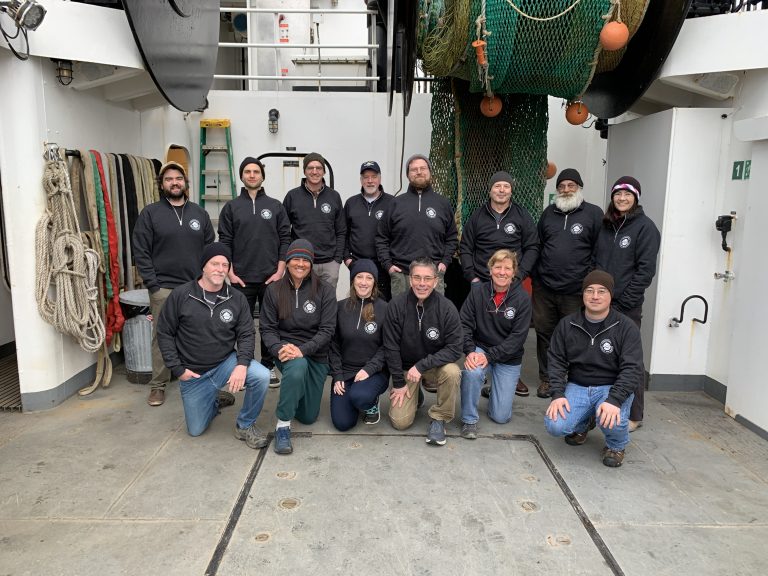
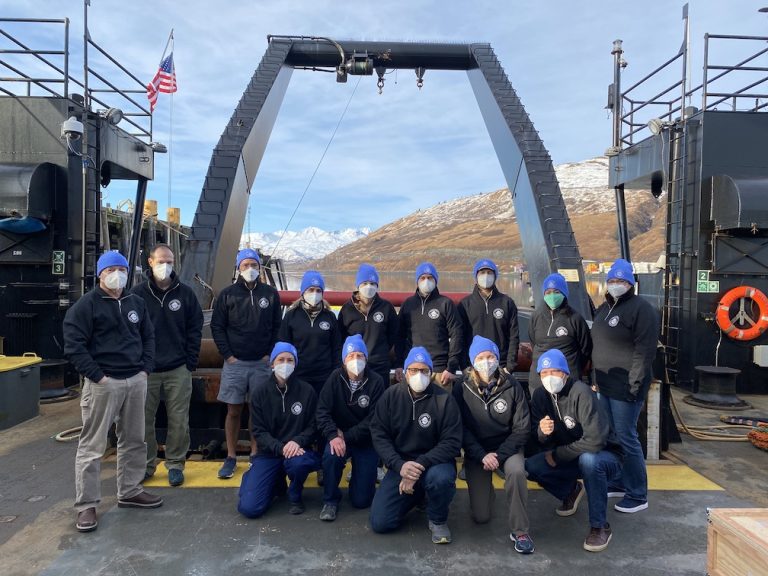
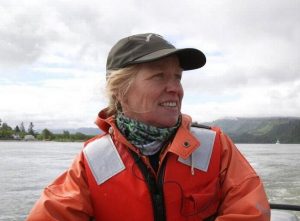 Dr. Laurie Weitkamp has focused on Pacific salmon conservation, research, and management since joining the Northwest Fisheries Science Center (USA) in 1992. Her research focuses on the ecology of Pacific salmon in estuarine and marine environments. She is particularly interested in how physical conditions influence biological processes that are important for salmon survival, including the impacts of climate change. On the management side, she serves on the Coho Technical Committee of the Pacific Salmon Commission. Laurie was a member of the scientific team on the 2019 International Gulf of Alaska Expedition and will be out again in winter 2022 on the NOAA ship, the Bell M. Shimada.
Dr. Laurie Weitkamp has focused on Pacific salmon conservation, research, and management since joining the Northwest Fisheries Science Center (USA) in 1992. Her research focuses on the ecology of Pacific salmon in estuarine and marine environments. She is particularly interested in how physical conditions influence biological processes that are important for salmon survival, including the impacts of climate change. On the management side, she serves on the Coho Technical Committee of the Pacific Salmon Commission. Laurie was a member of the scientific team on the 2019 International Gulf of Alaska Expedition and will be out again in winter 2022 on the NOAA ship, the Bell M. Shimada.
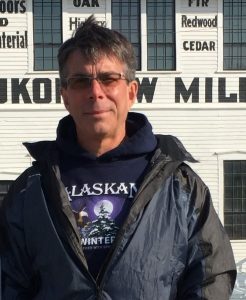 Dr. Ed Farley is the Program Manager for the Ecosystem Monitoring and Assessment (EMA) Program at the Alaska Fisheries Science Center, Auke Bay Laboratories in Juneau, Alaska, USA. The EMA program conducts integrated ecosystem research (oceanography to fish) in Alaska’s large marine ecosystems (Gulf of Alaska, Bering Sea, and Chukchi Sea) to examine the impact of climate change and variability on recruitment/survival of commercially important groundfish and salmon populations. Ed’s interest in fisheries began during the 1980s and 1990s, when he commercial fished for sockeye salmon in Bristol Bay. Since that time, Ed completed a BS in Mathematics at the University of Washington and a MS and PhD in Fisheries from the University of Alaska Fairbanks. Ed’s current research examines how reductions in Arctic sea ice and associated changes in the physical environment influence the flow of energy through the ecosystem in the northern Bering and Chukchi Seas.
Dr. Ed Farley is the Program Manager for the Ecosystem Monitoring and Assessment (EMA) Program at the Alaska Fisheries Science Center, Auke Bay Laboratories in Juneau, Alaska, USA. The EMA program conducts integrated ecosystem research (oceanography to fish) in Alaska’s large marine ecosystems (Gulf of Alaska, Bering Sea, and Chukchi Sea) to examine the impact of climate change and variability on recruitment/survival of commercially important groundfish and salmon populations. Ed’s interest in fisheries began during the 1980s and 1990s, when he commercial fished for sockeye salmon in Bristol Bay. Since that time, Ed completed a BS in Mathematics at the University of Washington and a MS and PhD in Fisheries from the University of Alaska Fairbanks. Ed’s current research examines how reductions in Arctic sea ice and associated changes in the physical environment influence the flow of energy through the ecosystem in the northern Bering and Chukchi Seas.
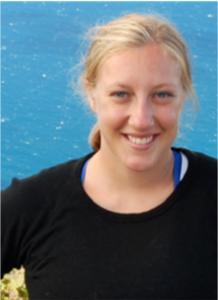 Emily Lemagie is a research physical scientist at NOAA’s Pacific Marine Environmental Laboratory (PMEL) in Seattle, Washington. She is a PI for the EcoFOCI program leading studies of the dynamic relationships among climate, fisheries, and the marine environment. Her work focuses on understanding ocean dynamics and the impact of physical processes on marine ecosystems in the North Pacific Ocean, Gulf of Alaska, Bering Sea, and U.S. Arctic.
Emily Lemagie is a research physical scientist at NOAA’s Pacific Marine Environmental Laboratory (PMEL) in Seattle, Washington. She is a PI for the EcoFOCI program leading studies of the dynamic relationships among climate, fisheries, and the marine environment. Her work focuses on understanding ocean dynamics and the impact of physical processes on marine ecosystems in the North Pacific Ocean, Gulf of Alaska, Bering Sea, and U.S. Arctic.
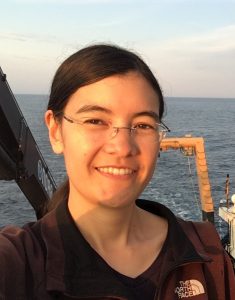 Tanya Rogers is a research fish biologist at the NOAA Southwest Fisheries Science Center in Santa Cruz, California. She conducts basic and applied research on marine ecological population and community dynamics, assists with stock assessments for west coast rockfishes and Chinook salmon, and assists with the annual Rockfish Recruitment and Ecosystem Assessment Survey on the coast of California. She also does scientific illustration and graphic design. Tanya has a Ph.D. in Ecology, Evolution, and Marine Biology from Northeastern University.
Tanya Rogers is a research fish biologist at the NOAA Southwest Fisheries Science Center in Santa Cruz, California. She conducts basic and applied research on marine ecological population and community dynamics, assists with stock assessments for west coast rockfishes and Chinook salmon, and assists with the annual Rockfish Recruitment and Ecosystem Assessment Survey on the coast of California. She also does scientific illustration and graphic design. Tanya has a Ph.D. in Ecology, Evolution, and Marine Biology from Northeastern University.
 Wesley Strasburger is a fisheries research biologist at the Alaska Fisheries Science Center, Auke Bay Labs in Juneau, Alaska. He is also currently a PhD student at the University of Alaska College of Fisheries and Ocean Sciences. His previous work has primarily been focused on feeding ecology during the early life history of Alaskan fishes, including groundfishes, Pacific salmon, and spiny dogfish sharks. He has served as the Chief Scientist on U.S. fisheries oceanography and ecosystem surveys in the Gulf of Alaska, Bering Sea, and Chukchi Seas over the past 6 years. His PhD work is focused on the early life history ecology, growth, and subsequent recruitment of juvenile sablefish in the Gulf of Alaska.
Wesley Strasburger is a fisheries research biologist at the Alaska Fisheries Science Center, Auke Bay Labs in Juneau, Alaska. He is also currently a PhD student at the University of Alaska College of Fisheries and Ocean Sciences. His previous work has primarily been focused on feeding ecology during the early life history of Alaskan fishes, including groundfishes, Pacific salmon, and spiny dogfish sharks. He has served as the Chief Scientist on U.S. fisheries oceanography and ecosystem surveys in the Gulf of Alaska, Bering Sea, and Chukchi Seas over the past 6 years. His PhD work is focused on the early life history ecology, growth, and subsequent recruitment of juvenile sablefish in the Gulf of Alaska.
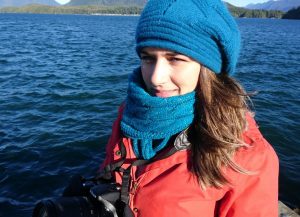 Dr. Genyffer Troina is a biologist interested in the trophic ecology and habitat use of marine top predators. Genyffer has been applying natural chemical tracers, such as carbon and nitrogen stable isotopes, to study the feeding habits, inter-specific trophic interactions and habitat use of cetaceans, as well as the food webs that sustain these marine apex predators. Genyffer is currently a postdoctoral research fellow at the Institute for the Oceans and Fisheries, University of British Columbia, at the Pelagic Ecosystems Lab, working with Dr. Brian Hunt on the IYS Expedition food web data. Genyffer’s main goal is to investigate the trophic pathways that sustain salmon in the high seas, potentially affecting their productivity. Genyffer will be analysing the stable isotope and fatty acid compositions of different organisms comprising the pelagic food webs throughout the North Pacific to assess how spatial patterns in the trophic structure of the food webs reflect oceanographic conditions.
Dr. Genyffer Troina is a biologist interested in the trophic ecology and habitat use of marine top predators. Genyffer has been applying natural chemical tracers, such as carbon and nitrogen stable isotopes, to study the feeding habits, inter-specific trophic interactions and habitat use of cetaceans, as well as the food webs that sustain these marine apex predators. Genyffer is currently a postdoctoral research fellow at the Institute for the Oceans and Fisheries, University of British Columbia, at the Pelagic Ecosystems Lab, working with Dr. Brian Hunt on the IYS Expedition food web data. Genyffer’s main goal is to investigate the trophic pathways that sustain salmon in the high seas, potentially affecting their productivity. Genyffer will be analysing the stable isotope and fatty acid compositions of different organisms comprising the pelagic food webs throughout the North Pacific to assess how spatial patterns in the trophic structure of the food webs reflect oceanographic conditions.
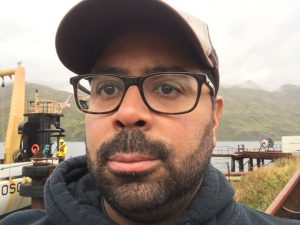 Jamal Moss is a fisheries research biologist at the Alaska Fisheries Science Center, Auke Bay Labs in Juneau, Alaska. His primary research focus is on juvenile salmon ecology and the feeding ecology of young of the year marine fishes. He has led fisheries oceanographic surveys for over 18 years and is currently leading a multidisciplinary research team developing an Integrated Ecosystem Assessment for the Gulf of Alaska.
Jamal Moss is a fisheries research biologist at the Alaska Fisheries Science Center, Auke Bay Labs in Juneau, Alaska. His primary research focus is on juvenile salmon ecology and the feeding ecology of young of the year marine fishes. He has led fisheries oceanographic surveys for over 18 years and is currently leading a multidisciplinary research team developing an Integrated Ecosystem Assessment for the Gulf of Alaska.
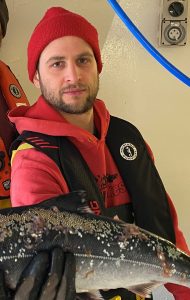 Christoph Deeg is first and foremost a biologist, with a background reflecting a broad interest in all “living” things. He started his research career in Germany and made contributions to a diverse number of fields including genetics and genomics of microorganisms and animals, fisheries research in the North Atlantic and North Sea, immunology of the innate immune system, conservation biology of salmon stocks and habitat on the central British Columbia coast, virology on the interactions of influenza with the innate immune system, and environmental microbiology. His PhD research at the University of British Columbia explored parasitic interactions in aquatic microorganisms, from giant viruses to predatory bacteria that form the base of the food web. Being a passionate outdoor enthusiast, he was able to take several field trips around British Columbia as well as the Caribbean to collect samples. After graduating, he decided to apply his broad skillset in organismal, molecular, and computational approaches with his passion for fieldwork to the management and conservation of Pacific salmon, a topic that he felt strongly about since moving to British Columbia. Christoph considers that having the opportunity to kick-start work in this field by joining the International Year of the Salmon Expeditions is both a huge opportunity and an honour, and one that he is very much looking forward too!
Christoph Deeg is first and foremost a biologist, with a background reflecting a broad interest in all “living” things. He started his research career in Germany and made contributions to a diverse number of fields including genetics and genomics of microorganisms and animals, fisheries research in the North Atlantic and North Sea, immunology of the innate immune system, conservation biology of salmon stocks and habitat on the central British Columbia coast, virology on the interactions of influenza with the innate immune system, and environmental microbiology. His PhD research at the University of British Columbia explored parasitic interactions in aquatic microorganisms, from giant viruses to predatory bacteria that form the base of the food web. Being a passionate outdoor enthusiast, he was able to take several field trips around British Columbia as well as the Caribbean to collect samples. After graduating, he decided to apply his broad skillset in organismal, molecular, and computational approaches with his passion for fieldwork to the management and conservation of Pacific salmon, a topic that he felt strongly about since moving to British Columbia. Christoph considers that having the opportunity to kick-start work in this field by joining the International Year of the Salmon Expeditions is both a huge opportunity and an honour, and one that he is very much looking forward too!
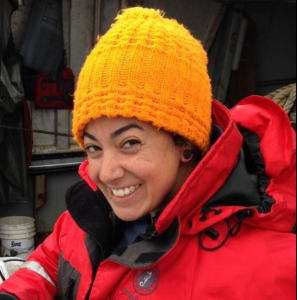 Sabrina Garcia is a research biologist with the State of Alaska’s Department of Fish and Game based in Anchorage. Her work focuses primarily on the early marine ecology (abundance, distribution, and diet) of western Alaska juvenile Chinook salmon in the Bering Sea in collaboration with the National Oceanic and Atmospheric Administration. She also leads surveys in the southern Bering Sea to determine the migration timing of Kuskokwim and Bristol Bay stocks of juvenile Chinook salmon. Some of her new projects include forecasting adult runs of Yukon River fall chum salmon, estimating the stock composition of immature Chinook salmon in the eastern Bering Sea, and identifying the migratory movements of salmon sharks in the Bering Sea ecosystem.
Sabrina Garcia is a research biologist with the State of Alaska’s Department of Fish and Game based in Anchorage. Her work focuses primarily on the early marine ecology (abundance, distribution, and diet) of western Alaska juvenile Chinook salmon in the Bering Sea in collaboration with the National Oceanic and Atmospheric Administration. She also leads surveys in the southern Bering Sea to determine the migration timing of Kuskokwim and Bristol Bay stocks of juvenile Chinook salmon. Some of her new projects include forecasting adult runs of Yukon River fall chum salmon, estimating the stock composition of immature Chinook salmon in the eastern Bering Sea, and identifying the migratory movements of salmon sharks in the Bering Sea ecosystem.
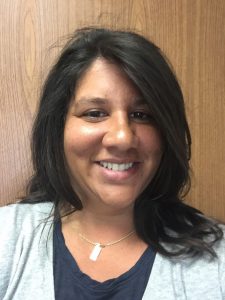 Marisa Litz is a research scientist with the Washington Department of Fish and Wildlife in Olympia, Washington and serves on the Coho Technical Committee of the Pacific Salmon Commission. Marisa’s unit conducts life cycle monitoring of native and non-native fishes in coastal Washington. She is interested in understanding how environmental variability throughout freshwater and marine phases affects the abundance, productivity, spatial distribution, and life history diversity of Pacific salmon and trout. One of the projects she oversees is a full capture trap and weir that enumerates juvenile and adult coho salmon returning to western Washington. The project produces estimates of marine survival that have been used to forecast coho run sizes in western Washington for forty years. Marisa received her M.S. and Ph.D. from Oregon State University working with scientists from NOAA where her work focused on the feeding ecology of juvenile salmonids based on data collected from surveys in the northern California Current. Raised in Maine and the Maritime Provinces, Marisa is a proud dual citizen of the U.S. and Canada and excited to be a part of the scientific team on board the NOAA Bell M. Shimada 2022 Pan-Pacific Winter High Seas Expedition.
Marisa Litz is a research scientist with the Washington Department of Fish and Wildlife in Olympia, Washington and serves on the Coho Technical Committee of the Pacific Salmon Commission. Marisa’s unit conducts life cycle monitoring of native and non-native fishes in coastal Washington. She is interested in understanding how environmental variability throughout freshwater and marine phases affects the abundance, productivity, spatial distribution, and life history diversity of Pacific salmon and trout. One of the projects she oversees is a full capture trap and weir that enumerates juvenile and adult coho salmon returning to western Washington. The project produces estimates of marine survival that have been used to forecast coho run sizes in western Washington for forty years. Marisa received her M.S. and Ph.D. from Oregon State University working with scientists from NOAA where her work focused on the feeding ecology of juvenile salmonids based on data collected from surveys in the northern California Current. Raised in Maine and the Maritime Provinces, Marisa is a proud dual citizen of the U.S. and Canada and excited to be a part of the scientific team on board the NOAA Bell M. Shimada 2022 Pan-Pacific Winter High Seas Expedition.
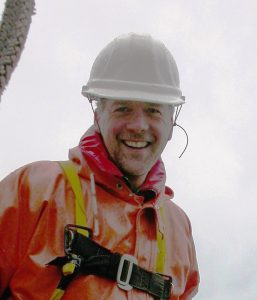 Jim Murphy is a research biologist with the Salmon Ocean Ecology and Bycatch Analysis group and the Ecosystem Monitoring and Assessment program at the Alaska Fisheries Science Center in Juneau, Alaska. He has led surface trawl and ecosystem research surveys in the Northern Bering Sea and Southeast Alaska over the past 20 years, with a focus on juvenile abundance, survival, ecology, and life-history of Yukon River Chinook salmon. He is a member of the Yukon River Panel’s Joint Technical Committee and provides technical support on pre-season run-size forecasts and bycatch of Yukon River salmon.
Jim Murphy is a research biologist with the Salmon Ocean Ecology and Bycatch Analysis group and the Ecosystem Monitoring and Assessment program at the Alaska Fisheries Science Center in Juneau, Alaska. He has led surface trawl and ecosystem research surveys in the Northern Bering Sea and Southeast Alaska over the past 20 years, with a focus on juvenile abundance, survival, ecology, and life-history of Yukon River Chinook salmon. He is a member of the Yukon River Panel’s Joint Technical Committee and provides technical support on pre-season run-size forecasts and bycatch of Yukon River salmon.
Ryan McCabe is a Research Physical Scientist at the NOAA Pacific Marine Environmental Laboratory in Seattle, Washington. His expertise is in coastal physical oceanography.
 Ben is a research biologist with the State of Alaska’s Department of Fish and Game based in Anchorage. He is a member of the Salmon Ocean Ecology Program, a statewide program that is tasked with understanding the marine life of Alaska salmon. During his master’s work at the University of Alaska Fairbanks, he took part in multiple surveys of the Chukchi and Beaufort seas to better understand Arctic fish abundance, distribution, and dietary patterns. Over the past several years, he has worked on the Yukon and Kuskokwim rivers as a fishery biologist focusing on both research and management issues. His current projects primarily focus on examining variability in Chinook salmon diets and contributing to pink salmon run forecasting efforts.
Ben is a research biologist with the State of Alaska’s Department of Fish and Game based in Anchorage. He is a member of the Salmon Ocean Ecology Program, a statewide program that is tasked with understanding the marine life of Alaska salmon. During his master’s work at the University of Alaska Fairbanks, he took part in multiple surveys of the Chukchi and Beaufort seas to better understand Arctic fish abundance, distribution, and dietary patterns. Over the past several years, he has worked on the Yukon and Kuskokwim rivers as a fishery biologist focusing on both research and management issues. His current projects primarily focus on examining variability in Chinook salmon diets and contributing to pink salmon run forecasting efforts.
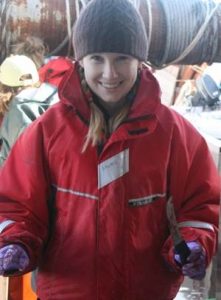 Katie Howard is a fisheries scientist and lead of the Salmon Ocean Ecology Program (SOEP) at the Alaska Department of Fish and Game. Her work focuses on understanding the marine life of Alaskan salmon stocks and using this information to develop fisheries management tools and to inform drivers of population dynamics. A major emphasis of her work in SOEP includes developing research partnerships with scientists who have varied expertise, and the IYS winter expedition provides a unique opportunity to connect with researchers internationally who are also passionate about understanding Pacific salmon and their marine ecosystems. While over the past dozen years she has been in the chilly waters of the Bering Sea and Gulf of Alaska, she received her Ph.D. from the University of Hawai‛i, Mānoa studying parrotfishes in much warmer waters.
Katie Howard is a fisheries scientist and lead of the Salmon Ocean Ecology Program (SOEP) at the Alaska Department of Fish and Game. Her work focuses on understanding the marine life of Alaskan salmon stocks and using this information to develop fisheries management tools and to inform drivers of population dynamics. A major emphasis of her work in SOEP includes developing research partnerships with scientists who have varied expertise, and the IYS winter expedition provides a unique opportunity to connect with researchers internationally who are also passionate about understanding Pacific salmon and their marine ecosystems. While over the past dozen years she has been in the chilly waters of the Bering Sea and Gulf of Alaska, she received her Ph.D. from the University of Hawai‛i, Mānoa studying parrotfishes in much warmer waters.
 Iris Ekmanis is a NOAA Corps Officer at the Pacific Marine Environmental Laboratory in Seattle, Washington. She holds a degree in Marine Science from the University of Hawai’i, and has a background in the maritime industry. Prior to PMEL she served as a Junior Officer on the NOAA Ship Fairweather, a hydrographic research vessel based out of Ketchikan, Alaska. Iris grew up on the Big Island of Hawai’i, and is dedicated to ocean conservation.
Iris Ekmanis is a NOAA Corps Officer at the Pacific Marine Environmental Laboratory in Seattle, Washington. She holds a degree in Marine Science from the University of Hawai’i, and has a background in the maritime industry. Prior to PMEL she served as a Junior Officer on the NOAA Ship Fairweather, a hydrographic research vessel based out of Ketchikan, Alaska. Iris grew up on the Big Island of Hawai’i, and is dedicated to ocean conservation.
 Kyle Shedd is a fisheries geneticist with the State of Alaska’s Department of Fish and Game, Commercial Fisheries Division, Gene Conservation Laboratory based in Anchorage. He completed his master’s degree at the University of Alaska Anchorage where he studied the trophic dynamics of kokanee in Southwest Alaska. His current work focuses primarily on using genetic stock identification to estimate the stock composition of different salmon species harvested in commercial and sport fisheries in Southeast Alaska and using genetic parentage analysis to better understand hatchery-wild salmon interactions of pink salmon in Prince William Sound and chum salmon in Southeast Alaska.
Kyle Shedd is a fisheries geneticist with the State of Alaska’s Department of Fish and Game, Commercial Fisheries Division, Gene Conservation Laboratory based in Anchorage. He completed his master’s degree at the University of Alaska Anchorage where he studied the trophic dynamics of kokanee in Southwest Alaska. His current work focuses primarily on using genetic stock identification to estimate the stock composition of different salmon species harvested in commercial and sport fisheries in Southeast Alaska and using genetic parentage analysis to better understand hatchery-wild salmon interactions of pink salmon in Prince William Sound and chum salmon in Southeast Alaska.
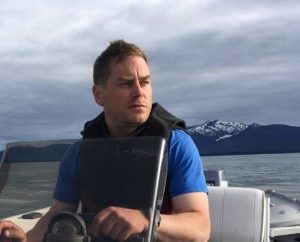 Dave Nicolls is a Fisheries Biologist Technician with Azura Consulting, LLC. at NOAA’s Auke Bay Laboratories (ABL) in Juneau. He has studied Forestry and Fisheries at the University of Idaho and the University of Alaska Southeast.
Dave Nicolls is a Fisheries Biologist Technician with Azura Consulting, LLC. at NOAA’s Auke Bay Laboratories (ABL) in Juneau. He has studied Forestry and Fisheries at the University of Idaho and the University of Alaska Southeast.
Dave spent several years as a cargo agent for a local airline, then began aquaculture work with Douglas Island Pink and Chum, at Macaulay Salmon Hatchery in Juneau, as well as various remote salmon rearing sites. Prior to contracting at ABL in Juneau, he lived and worked for six years on Southern Baranof Island as a fish culturist with Armstrong Keta, Inc., at Port Armstrong Hatchery. His work with the Ecosystem Monitoring and Assessment Program has included numerous assignments returning to southern Baranof to assist with research and operation of the NMFS Little Port Walter Marine Research Station. Other field work has included assisting with Southeast Alaska Coastal Monitoring, Bering Sea, and Gulf of Alaska fisheries, oceanography, and ecosystem research surveys. Processing various samples collected throughout the year occupies the balance of his time, including removing/preserving otoliths, mounting salmon scales for ageing, and other bioprocessing of salmon and non-salmon species in support of research missions.
 Abi Wells works for Lynker Technologies supporting NOAA’s Northwest Fisheries Science Center (NWFSC) in the Genetics and Evolution program. Abi provides technical support for environmental DNA studies, while leading the NWFSC’s collection of genetic vouchers for marine fish from the Eastern Pacific. Abi is looking forward to assisting the IYS Shimada cruise eDNA collection efforts to expand her knowledge of eDNA semi-autonomous collection tools.
Abi Wells works for Lynker Technologies supporting NOAA’s Northwest Fisheries Science Center (NWFSC) in the Genetics and Evolution program. Abi provides technical support for environmental DNA studies, while leading the NWFSC’s collection of genetic vouchers for marine fish from the Eastern Pacific. Abi is looking forward to assisting the IYS Shimada cruise eDNA collection efforts to expand her knowledge of eDNA semi-autonomous collection tools.
Brandon Chasco is a research ecologist with the National Marine Fisheries Service. He is broadly interested in quantitative ecology and has recently begun exploring the use of remote systems to map observations of species assemblages at different spatial and temporal scales to physical drivers in marine systems. He is excited to assist with the hydroacoustic data collection in this year’s International Year of the Salmon cruise and examine the associations between salmon, krill and small pelagics in the open ocean.
 Alex Andrews is a fisheries research biologist with NOAA’s Alaska Fisheries Science Center, Auke Bay Laboratories in Juneau, Alaska. He has served as Chief Scientist in the Bering and Chukchi Seas on Bering Arctic and Subarctic Integrated Surveys. His main interests are the trophic ecology of forage fishes, including juvenile Pollock, Pacific cod, capelin, herring, as well as juvenile salmonids and how climate influences their distributions, diets, and energetics. Alex is excited to participate in the International Year of the Salmon survey and to find out more about salmon overwintering in the Gulf of Alaska.
Alex Andrews is a fisheries research biologist with NOAA’s Alaska Fisheries Science Center, Auke Bay Laboratories in Juneau, Alaska. He has served as Chief Scientist in the Bering and Chukchi Seas on Bering Arctic and Subarctic Integrated Surveys. His main interests are the trophic ecology of forage fishes, including juvenile Pollock, Pacific cod, capelin, herring, as well as juvenile salmonids and how climate influences their distributions, diets, and energetics. Alex is excited to participate in the International Year of the Salmon survey and to find out more about salmon overwintering in the Gulf of Alaska.
 Alicia Billings is a fisheries research biologist at the Northwest Fisheries Science Center in Newport, Oregon. She works with the Fisheries Engineering and Acoustic Technology Team as the lead biologist for the Joint U.S.-Canada Integrated Ecosystem and Pacific Hake Acoustic Trawl Survey. Currently, her main focus is spelunking through decades of collected diet data to create a comprehensive summary of Pacific hake diet from the survey area. She also recently started a master’s program in Data Analytics through Oregon State University.
Alicia Billings is a fisheries research biologist at the Northwest Fisheries Science Center in Newport, Oregon. She works with the Fisheries Engineering and Acoustic Technology Team as the lead biologist for the Joint U.S.-Canada Integrated Ecosystem and Pacific Hake Acoustic Trawl Survey. Currently, her main focus is spelunking through decades of collected diet data to create a comprehensive summary of Pacific hake diet from the survey area. She also recently started a master’s program in Data Analytics through Oregon State University.
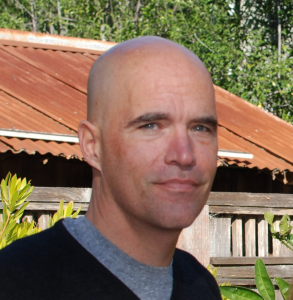 Steve Lindley is the director of the NMFS Southwest Fisheries Science Center’s Fisheries Ecology Division in Santa Cruz, CA and a researcher at UC Santa Cruz. He leads the Center’s research programs on California’s demersal and anadromous species. His research interests include the ecology of anadromous fish, statistical and numerical modeling, time series analysis, and animal telemetry, with a current focus on coupled physical-biological models to support management of freshwater, fish habitat, and fish populations in a changing climate.
Steve Lindley is the director of the NMFS Southwest Fisheries Science Center’s Fisheries Ecology Division in Santa Cruz, CA and a researcher at UC Santa Cruz. He leads the Center’s research programs on California’s demersal and anadromous species. His research interests include the ecology of anadromous fish, statistical and numerical modeling, time series analysis, and animal telemetry, with a current focus on coupled physical-biological models to support management of freshwater, fish habitat, and fish populations in a changing climate.
 Charles Kovach is a marine ecologist working for NOAA/NESDIS/STAR as a contractor with Global Science & Technology. My focus is on global ocean validation/calibration of ocean color satellites, primarily the VIIRS satellites currently.
Charles Kovach is a marine ecologist working for NOAA/NESDIS/STAR as a contractor with Global Science & Technology. My focus is on global ocean validation/calibration of ocean color satellites, primarily the VIIRS satellites currently.
Scientific Equipment on Board

A hydrographic winch for will deploy a CTD (conductivity, temperature, and depth), and rosette of Niskin bottles to collect water samples. The CTD uses an electromechanical cable so the data from the CTD is provided in real time. This means that you can watch the water column properties (temperature, salinity, oxygen, flourescence, and turbidity as the CTD descends.
 The NOAA Bell M. Shimada has multiple labs (wet, dry, chemical, electronics and computer, and hydrographic). She also has a controlled climate space, walk in freezer and ultracold chest freezer for sample storage.
The NOAA Bell M. Shimada has multiple labs (wet, dry, chemical, electronics and computer, and hydrographic). She also has a controlled climate space, walk in freezer and ultracold chest freezer for sample storage.
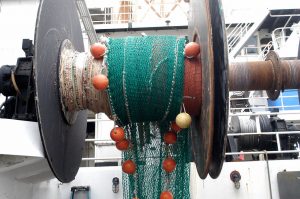 Scientists will be fishing with a Cantrawl 400 midwater rope trawl towed at the surface. The net has hexagonal mesh in the wings and body, is 198 meters long, with a headrope length of 120 m, and 12 mm liner in the codend. Steel alloy 5 m2 doors are used to hold the net open. The net is towed at 4.5-5 knots.
Scientists will be fishing with a Cantrawl 400 midwater rope trawl towed at the surface. The net has hexagonal mesh in the wings and body, is 198 meters long, with a headrope length of 120 m, and 12 mm liner in the codend. Steel alloy 5 m2 doors are used to hold the net open. The net is towed at 4.5-5 knots.
All catch data (species, number, size, samples collected) will be electronically recorded using a catch logging system (CLAMS) developed by the Alaska Fisheries Science Center. Specimen collections will be tracked electronically with barcode readers and barcoded specimen tags.

